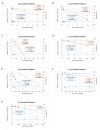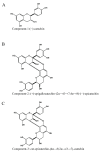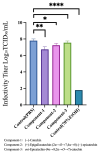In Vitro Suppression Effects of Ephedra przewalskii Stapf-Derived Natural Compounds on SARS-CoV-2
- PMID: 41010483
- PMCID: PMC12473021
- DOI: 10.3390/nu17182958
In Vitro Suppression Effects of Ephedra przewalskii Stapf-Derived Natural Compounds on SARS-CoV-2
Abstract
Background: Ephedra przewalskii Stapf stems are a traditional Mongolian medicine commonly used to treat infectious diseases. Previous in vitro experiments have shown that the extract powder derived from its stems possesses antiviral activity. However, the active compounds responsible for this activity in E. przewalskii Stapf have not yet been identified or evaluated. This study aimed to identify the active components in E. przewalskii that exhibit antiviral effects against SARS-CoV-2 in vitro and validate their antiviral activity.
Methods: E. przewalskii stem extracts were subjected to high-performance liquid chromatography with varying methanol ratios in the mobile phase to obtain fractions with different polarities. Antiviral activity was assessed by infecting VeroE6/TMPRSS2 cells with the SARS-CoV-2 Delta strain and treating them with the obtained fractions. Infectious titers were measured using the 50% tissue culture infective dose (TCID50) method, and half-maximal inhibitory concentration (IC50) values were calculated for each fraction. The active components in the two fractions with the highest antiviral activity were identified and structurally characterized by nuclear magnetic resonance analysis. The antiviral activity of these compounds was confirmed by adding them to SARS-CoV-2-infected cells and measuring their infectious titers using the TCID50 method. The IC50 values were also calculated. Viral-particle inactivation assays were conducted by mixing the extracts with SARS-CoV-2 and measuring infectious titers.
Results: (-)-Catechin, (+)-epigallocatechin-(2α→O→7,4α→8)-(-)-epicatechin, and ent-epicatechin-(4α→8;2α→O→7)-catechin were isolated from E. przewalskii. These compounds exhibited significant antiviral activity against SARS-CoV-2 but demonstrated minimal direct virucidal effects.
Conclusion: (-)-Catechin, (+)-epigallocatechin-(2α→O→7,4α→8)-(-)-epicatechin, and ent-epicatechin-(4α→8;2α→O→7)-catechin exhibit antiviral activity against SARS-CoV-2 in infected cells.
Keywords: Ephedra przewalskii Stapf; IC50; SARS-CoV-2; natural compounds.
Conflict of interest statement
Prof. Keiko Ogawa-Ochiai has received collaborative research funding from Tsumura & Co. The other authors declare no conflicts of interest.
Figures




References
-
- World Health Organization COVID-19 Cases|WHO COVID-19 Dashboard. [(accessed on 14 January 2025)]. Available online: https://data.who.int/dashboards/covid19/cases?n=c.
-
- Ni W., Wu W., Li K. A Message Efficient Intersection Control Algorithm for Intelligent Transportation in Smart Cities. Future Gener. Comput. Syst. 2017;76:339–349. doi: 10.1016/j.future.2016.10.033. - DOI
-
- Medical Herbs Study Center Хoнин Зээргэнэ|Эмийн Ургамал Судлалын Төв. [(accessed on 14 January 2025)]. Available online: https://urgamal.com/product/ephedra-przewalskii-stapf.html.
-
- Kakimoto M., Nomura T., Nazmul T., Yamamoto A., Sasaki H., Higashiura A., Ito M., Ohge H., Mikage M., Ogawa K.O., et al. In Vitro Anti-Severe Acute Respiratory Syndrome Coronavirus 2 Effect of Ephedra Przewalskii Stapf Extract. J. Ethnopharmacol. 2024;319:117341. doi: 10.1016/j.jep.2023.117341. - DOI - PubMed
MeSH terms
Substances
Grants and funding
LinkOut - more resources
Full Text Sources
Research Materials
Miscellaneous

